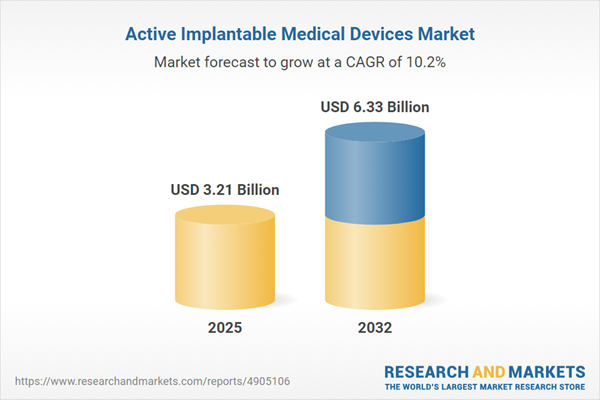Speak directly to the analyst to clarify any post sales queries you may have.
The active implantable medical devices market is undergoing a significant transformation, powered by technological innovation, regulatory progress, and shifts in healthcare delivery. For senior decision-makers, understanding these developments is critical to navigating investment priorities, operational strategies, and long-term growth opportunities.
Market Snapshot: Active Implantable Medical Devices
The Active Implantable Medical Devices Market grew from USD 2.91 billion in 2024 to USD 3.21 billion in 2025 and is forecast to reach USD 6.33 billion by 2032, reflecting a CAGR of 10.20%. This strong trajectory is driven by advances in miniaturization, digital connectivity, and integration of AI-powered features, enhancing personalized therapies, diagnostics, and remote monitoring in clinical practice. The sector’s momentum is supported by growing demand for connected medical solutions, evolving care models, and the need for real-time data to inform patient management and outcomes across hospital systems and ambulatory care settings.
Scope & Segmentation of the Active Implantable Medical Devices Market
This comprehensive analysis provides precise segmentation and covers all major facets that drive the global active implantable medical devices market:
- Device Types: Market includes cardiac pacemakers, cochlear implants, implantable cardioverter defibrillators, infusion pumps, and neurostimulators, each supporting different therapeutic applications and care settings.
- Technologies: Both non-rechargeable and rechargeable device platforms are addressed, with varied adoption trends based on durability, patient preference, and intended therapy duration.
- Patient Age Groups: Segments span adult, geriatric, and pediatric populations, with tailored device designs responding to age- and condition-specific requirements.
- Applications: Use cases encompass cardiology (including heart failure and rhythm management), endocrinology, neurology (such as deep brain and spinal cord stimulation), and otology, broadening clinical reach and patient eligibility.
- End Users: Key stakeholders include ambulatory surgical centers, clinics, private and public hospitals, each influencing procurement models and deployment rates.
- Regional Markets: Coverage includes the Americas (United States, Canada, Mexico, Brazil, Argentina, Chile, Colombia, Peru), Europe (UK, Germany, France, Russia, Italy, Spain, Netherlands, Sweden, Poland, Switzerland), Middle East (UAE, Saudi Arabia, Qatar, Turkey, Israel), Africa (South Africa, Nigeria, Egypt, Kenya), and Asia-Pacific (China, India, Japan, Australia, South Korea, Indonesia, Thailand, Malaysia, Singapore, Taiwan), capturing local market nuances and regulatory dynamics.
- Leading Companies: The landscape features Medtronic PLC, Abbott Laboratories, Boston Scientific Corporation, BIOTRONIK SE & Co. KG, Cochlear Limited, Edwards Lifesciences Corporation, LivaNova PLC, Nurotron Biotechnology Co. Ltd., Axonics, Inc., and Tame-Care, each shaping technology trajectories and supply strategies.
Tariff Impact on Supply Chains and Cost Structures
Starting in 2025, new tariffs imposed in the United States are prompting manufacturers to revise procurement and production approaches. Organizations prioritize regional sourcing for processors and specialty materials, with increased investments in domestic assembly processes. Redesigning devices to reduce dependency on imported components is influencing cost management, while hospitals and payers reevaluate contract terms and reimbursement to support adaptability. Companies adopting agile supply chain models are better positioned to maintain margin stability under changing regulatory and fiscal conditions.
Key Takeaways for Decision-Makers
- Integrated advancements in microelectronics, advanced materials, and software are facilitating more responsive devices that adjust therapies to individual patient profiles, supporting value-based healthcare delivery.
- Healthcare organizations are leveraging active implants to drive operational efficiency, limit in-person visits, and enable digital patient engagement platforms that streamline therapy management and outcome reporting.
- Accelerated innovation in this market is the result of close collaboration among clinicians, engineers, and data scientists, producing hybrid solutions that combine electrical and pharmaceutical functions in a single device.
- Regulatory bodies now require manufacturers to strengthen post-market surveillance and utilize real-world evidence to validate device safety and effectiveness, promoting both compliance and sustainable access.
- Market growth in emerging regional segments is significantly influenced by local reimbursement frameworks, manufacturing alliances, and harmonized regulatory policies, creating region-specific adoption curves.
- Strategic management of company portfolios—encompassing licensing, ecosystem partnerships, and mergers and acquisitions—is increasingly important for differentiated market positioning and access to specialized therapy segments.
Methodology & Data Sources
This report synthesizes structured interviews with clinical experts and industry leaders, complemented by secondary research from peer-reviewed scientific literature, regulatory disclosures, and patent databases. Findings are validated through triangulation and analytical methods, leveraging SWOT and scenario planning frameworks to present an objective market perspective.
Why This Report Matters
- Empowers senior executives to forecast technology adoption timelines and prepare for emerging regulatory requirements affecting implantable solutions.
- Delivers actionable insights on global and regional supply chain evolution, reimbursement trends, and therapy innovation, enabling effective strategy adjustment.
- Facilitates informed business development and investment decisions with comprehensive segmentation and competitive benchmarking within the active implantable medical devices landscape.
Conclusion
This report provides senior leaders with a structured analysis of technology, regulatory, and market forces shaping the active implantable medical devices sector. With clear insights, organizations can drive adaptive strategies for resilience and patient-centered innovation.
Additional Product Information:
- Purchase of this report includes 1 year online access with quarterly updates.
- This report can be updated on request. Please contact our Customer Experience team using the Ask a Question widget on our website.
Table of Contents
3. Executive Summary
4. Market Overview
7. Cumulative Impact of Artificial Intelligence 2025
List of Figures
Samples

LOADING...
Companies Mentioned
The key companies profiled in this Active Implantable Medical Devices market report include:- Medtronic PLC
- Abbott Laboratories
- Boston Scientific Corporation
- BIOTRONIK SE & Co. KG
- Cochlear Limited
- Edwards Lifesciences Corporation
- LivaNova PLC
- Nurotron Biotechnology Co. Ltd.
- Axonics, Inc.
- Tame-Care
Table Information
| Report Attribute | Details |
|---|---|
| No. of Pages | 186 |
| Published | October 2025 |
| Forecast Period | 2025 - 2032 |
| Estimated Market Value ( USD | $ 3.21 Billion |
| Forecasted Market Value ( USD | $ 6.33 Billion |
| Compound Annual Growth Rate | 10.2% |
| Regions Covered | Global |
| No. of Companies Mentioned | 11 |









